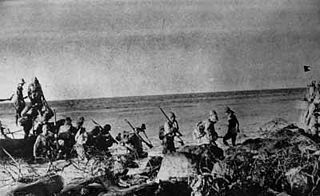External links
Coordinates: 7°01′S147°07′E / 7.017°S 147.117°E / -7.017; 147.117
| History | |
|---|---|
| Name | Yokohama Maru |
| Owner |
|
| Builder | Mitsubishi Dockyard & Engine Works, Nagaski |
| Launched | 30 January 1912 |
| Fate | Sunk by United States Navy planes |
| General characteristics | |
| Tonnage | 6,143 GRT |
| Length | 406 feet (124 m) [1] |
| Beam | 49 feet (15 m) |
| Draught | 27 feet (8 m) |
The Yokohama Maru was a 6,143-gross register ton passenger and cargo vessel built by Mitsubishi Dockyard & Engine Works, Nagaski for Nippon Yusen Kabushiki Kaisha and launched in 1912. The ship was used on the Guam to Japan route. She was requisitioned by the Imperial Japanese Army and fitted out as a troop transport.
On 8 December 1941, she was assigned to Operation "G", the invasion of Guam as one of 10 transports carrying Major General Horii Tomitaro's 55th Infantry Corps. [2] The naval operation was headed by the 4th Fleet operating out of Saipan consisting of minelayer Tsugaru as flagship; seaplane tender Kiyokawa Maru; 4 cruisers, Aoba, Furutaka, Kako, Kinugasa (Cruiser Division 6, detached from 1st Fleet); and 4 destroyers, Oboro (detached from Carrier Division 5 of the IJN 1st Air Fleet), and Kikuzuki, Uzuki, and Yūzuki (Destroyer Division 23, detached from Carrier Division 2, IJN 1st Air Fleet). The remaining ships all belonged to the Fifth Base Force, 4th Fleet consisting of Gunboat Division 7 (Hirotama Maru, Shotoku Maru), Subchaser Division 59 (subchasers Shonan Maru No. 5, Shonan Maru No. 6; netlayer Shofuku Maru), Subchaser Division 60 (subchasers Kyo Maru No. 8, Kyo Maru No. 10; netlayer Shuko Maru), and Minesweeper Division 15 (Fumi Maru No. 2, Seki Maru No. 3). [2] [3]
On 10 March 1942, while being unloaded off Salamaua, Yokohama Maru was attacked as part of the invasion fleet at Lae and Salamaua and was sunk at 07°01′S147°07′E / 7.017°S 147.117°E . [4] She was the first ever victim of American aerial torpedo Mk. 13

Shiranui was the second vessel to be commissioned in the 19-vessel Kagerō-class destroyers built for the Imperial Japanese Navy in the late 1930s under the Circle Three Supplementary Naval Expansion Program.

The 6th Fleet was a fleet of the Imperial Japanese Navy (IJN) that during World War II, had primary responsibility for the command of submarine operations.
The 5th Fleet was a fleet of the Imperial Japanese Navy, active during the early portions of the Second Sino-Japanese War, and again in World War II, primarily in the Aleutian campaign, during which it was augmented and designated the Northern Area Force.
The 4th Fleet was a fleet of the Imperial Japanese Navy. The Fourth Fleet designation was used during three separate periods. The initial designation was for a group of ships that were assigned to work together during the Russo-Japanese conflict and the period of its immediate aftermath. The second time the designation was used was during the Sino-Japanese conflict, and the third time was as a South Pacific area of command during the middle of the Pacific War.
The 3rd Fleet was a fleet of the Imperial Japanese Navy (IJN), which was created, and subsequently disbanded on six separate occasions and revived on five separate occasions.
The Kōtoku Maru was a 6,702 gross ton freighter that was built by Mitsubishi Jūkōgyō Kabushiki-kaisha, Nagasaki for Hiroumi Syozi Kabushiki Kaisha launched in 1937. She was requisitioned by the Imperial Japanese Navy and fitted out as an auxiliary ammunition ship.

Kongō Maru (金剛丸) was an 7,043 gross register ton passenger-cargo ship built by Harima Shipbuilding Company in Japan for Kokusai Kisen Kabushiki Kaisha in 1935. She was requisitioned by the Imperial Japanese Navy during the Second World War and converted to an armed merchant cruiser.
The SS China Maru was a 5,870-gross register ton cargo ship built by Kawasaki Dockyard Company, Kobe, for Kawasaki Kisen Kabushiki Kaisha in 1920.

Kaimei Maru was a Japanese troop transport ship operated by the Imperial Japanese Army during World War II which was sunk off Honshu on 4 September 1942 by the American submarine USS Guardfish. The ship was a British WWI Type B military cargo ship built by the Hong Kong and Whampoa Dock Company.
Hokkai Maru was a Kinai Maru-class auxiliary transport of the Imperial Japanese Navy during World War II. She participated in the Japanese occupation of British Borneo and was part of ill-fated convoy HI-71.
Fukuei Maru No. 15 was a Japanese cargo ship that was requisitioned by the Imperial Japanese Navy during World War II and converted into an auxiliary netlayer.
Nagara Maru was a Japanese cargo ship that was requisitioned by the Imperial Japanese Navy during World War II and converted into an auxiliary netlayer.
Korei Maru was a Japanese cargo ship that was requisitioned by the Imperial Japanese Navy during World War II and converted into an auxiliary netlayer.
Aso Maru was a Japanese cargo ship that was requisitioned by the Imperial Japanese Navy during World War II and converted into an auxiliary gunboat.
CH-7 or No. 7 was a No.4-class submarine chaser of the Imperial Japanese Navy during World War II.
Sanuki Maru (Japanese:讃岐丸) was a 1939-built cargo ship, requisitioned as a seaplane tender by the Imperial Japanese Navy during World War II.
Shonan Maru No. 17 was a Japanese fishing vessel that was requisitioned by the Imperial Japanese Navy during World War II and converted into an auxiliary subchaser.
Shonan Maru No. 7 was a Japanese whaling ship that was requisitioned by the Imperial Japanese Navy during World War II and converted into an auxiliary subchaser.
Cha-216 or No. 216 was a No.1-class auxiliary submarine chaser of the Imperial Japanese Navy that served during World War II.
Cha-228 or No. 228 was a No.1-class auxiliary submarine chaser of the Imperial Japanese Navy that served during World War II.